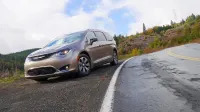2018 Chrysler Pacifica Hybrid | Mountain road / fuel economy review

Now, typically, minivans are huge boxes with a stratospheric center of gravity courtesy a whole bunch of steel, a whole bunch of panoramic sunroof glass, and a whole bunch of air ducting packed into the roof. This leads to a rather tippy driving experience that’s exacerbated by a soft suspension intended to provide pillow-like comfort for the kiddos in the back.
.

This would apply to the regular Pacifica, but the Hybrid, it’s different. Stuffed into the area where the Stow ‘n Go seats would normally stow and go into, this plug-in hybrid’s 96-cell lithium-ion battery pack is smack dab in the middle of the van and quite low to the ground. It’s exactly where you’d want to stuff 568 extra pounds to counteract all that weight up high.
It also settles that suspension down, resulting in a minivan that feels more buttoned down and poised with minimal rebound over bumps. Body roll is even kept nicely in check. This, despite balloonier, higher-profile tires than what you’d get in a comparable regular Pacifica. The steering could still use just a smidge more effort upon turn-in, but remains more reassuring and engaging than Honda’s disappointingly loosey-goosey steering.
Throttle response is different in the Pacifica Hybrid as well, providing ultra-smooth and torque-rich electric power delivery reminiscent of an EV. Even when the all-electric range has been depleted, the Pacifica Hybrid continues to feel more like an electric car than one that also has a gasoline engine aboard. It certainly helps that that engine is a smooth 3.6-liter V6 rather than a buzzy four-cylinder bound to make a racket. Unless you really gun the thing, it’s difficult to detect when puttering around town or at a steady highway cruise. In total, the Pacifica Hybrid is better to drive.
Actually, when I wrote “all-electric range” earlier, that’s not quite accurate. With the plug-in battery fully charged, the engine can still come on if the driving scenario requires it — say, should you really gun the thing — and there’s no “all-electric” mode as in most other plug-in hybrids. In fact, there are no drive modes at all.
Having said that, the Pacifica Hybrid is estimated to have an almost-all-electric range of 33 miles, according to the EPA. The car showed me 31 miles when I set off on my standard 75-mile vehicle evaluation route, which in the past, has confirmed the ranges of other plug-in hybrids, including the Honda Clarity and Kia Niro.
The Pacifica Hybrid initially managed only 20.8 miles, but picked up an extra 7 miles of range later in the drive when coasting down from the aforementioned mountain road. Frankly, my eval route isn’t the best environment for testing such things, but the figures aren’t terribly out of whack. During 121.4 miles of mixed driving consisting of my evaluation route plus general suburban outings, the trip computer showed I traveled 53.8 miles with the gasoline engine contributing and 67.6 miles on electric power. Given that I recharged it twice, that’s an average of 33.8 miles of electric range.
Besides my “general suburban outings” being more conducive to running on electricity, the Pacifica Hybrid still functions as a, well, hybrid when the almost-all-electric battery range is depleted. The electric motor is still utilized with power captured through regenerative breaking. As such, total fuel economy, according to the in-car fuel meter, was 31.3 mpg. Combined fuel economy, according to the EPA, is 32 mpg.
Of course, that 121.4 miles featured a lot of highway miles. If you just drop the kids off at school, drive a reasonable distance to and from work, and then recharge at night, you’d be looking at far better and more realistic fuel economy than I achieved.


No kids? Who cares! Two adults still enjoyed the comfier unstowable captain’s chairs and the entertainment system’s sudoku game.
Yet, there’s another area where the Pacifica Hybrid differs from its conventionally powered sibling. As the Stow ‘n Go bin is filled with batteries, the second row captain’s chairs must be physically removed to fully utilize the cargo area. Many have listed this as a negative for the Hybrid, and perhaps it will be for some, but there’s actually a positive.
The seats themselves are actually different. Without the need to fold flat, the Hybrid’s seats seem to be fuller in cushion and are substantially more comfortable than the Stow ‘n Go’s, which really aren’t that comfortable. Oh, they’ve definitely gotten better in the Pacifica, but those in the Hybrid are closer to what you’d get in the ultra-comfy Toyota Sienna or Kia Sedona. Sadly, they still don’t slide as far rearward.
So as far as this non-parent is concerned, the Chrysler Pacifica Hybrid is a better type of minivan. It’s not even that much pricier than the regular model — our long-term Limited’s equivalent gas model would only be $950 cheaper. You could easily pay that back in less than a year. Now, the price differences between the lower trims are in the thousands, but that’s a head-scratching investigation for another long-term post. For now, I’ll turn things back over to Michigan for more pressing family matters.
Related Video:




